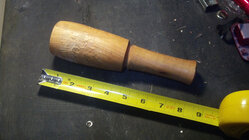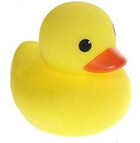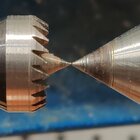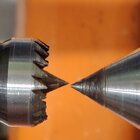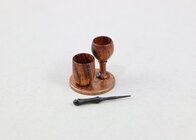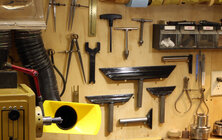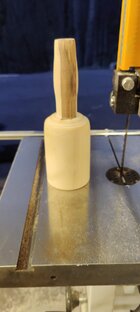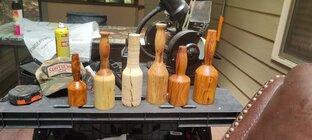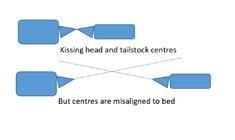Ok. Some time last year, I guess it was early summer, I had some problems with my Beall 3-wheel buffing system. As it turned out, the morse taper had been machined to an incorrect spec. I did not know this was the issue at first, I thought maybe I had damaged it somehow, as it wobbled in my headstock until I brought up the tailstock (and as I didn't know at first, it also wobbled during operation.) I looked around, and found some old threads on a number of forums (I think even this one) about other people having the same issue. This issue actually spanned back YEARS. I think over a decade. I found a fairly informative thread all the way back in 2016. So I realized the problem was legit.
I then discovered that the inside of the morse taper of my spindle on this Wen 14x20 lathe had been damaged, and that was causing problems inserting most of my other MT2 dead centers, collet chuck, etc. I contacted Lee Valley, who bought the rights to a bunch of Beall stuff when they closed their doors (I guess that was the end of 2022?) They checked the specs they were manufacturing to, and confirmed that there was a problem. It was NOT actually to MT2 spec! So they agreed to machine a new shaft with a proper MT2 on it, and sent it to me. It took a while for all of that to happen, so I'd taken my headstock apart, pulled out the spindle, and took it to a machinist who showed me some techniques he would use to level out the high spots. Which I did. That "mostly" fixed the issues (not entirely...and Wen's stock lately has been VERY spotty, so I haven't yet been able to get a replacement...new spindles seems to sell out in a heartbeat for some reason...and I guess they only get like 6 at a time??)
The problem I now have is, in disassembling the headstock so I could get the spindle out, then back in after fixing it up, I am having a heck of a time getting the headstock and tailstock properly aligned. I bought a short double-ended MT2 piece, so I could fit it into both the headstock and tailstock. I thought that would do the trick, but I still had some mispointing, so I bought an even longer shaft with double MT2. I thought that fixed it as well...and for longer things it seemed pretty good (?), but then I started turning shorter/smaller things again, and its quite clear that I STILL have a pointing problem.
SO...I'm wondering if any of you have advice, about how to optimally determine pointing for the headstock of a midi lathe. I thought the double-ended MT2 part would do it, but I'm starting to wonder if the tailstock is really up to the task. The way the tailstock is designed to fit into the ways, its not...perfect. Its ok, but it may not sit 100% perfectly. Thing is, before I had to take the spindle out, I didn't have pointing issues, so at some point everything was aligned. I thought about that before I took the headstock off, but couldn't (at the time) really think of a way to reference its current "exact" position (and down to say a thousandth!!), so I just did what I had to do. But I definitely have some pointing issues, and I'm not quite sure what the best way to resolve them is.
In part, I know I have a pointing issue, as if I put my sharpest live center (or even my sharpest dead center, both 60 deg) into the tailstock, and bring it up to a piece of wood I have rotating in a chuck in the headstock... REGARDLESS of the way I have that piece of wood chucked (could be my collet chuck, could be one of the four different wood chucks I have, in any of the wide array of jaws I have). The point of the live center, with the locking lever fully locked without even the minutest of wobble in the quill, will NOT touch the dead center moment of rotation in the wood. Instead, it will touch a little outside, and carve a tiny ring, or a very small circle, into the wood. So I'm off, by some thousandths (maybe even a couple hundredths), and I can't quite seem to dial it in...
I do have a dial indicator, with a magnetic base that I can latch onto my lathe bed. When I test with that, using a long strait shaft (although, I honestly don't know if its "perfectly" strait enough to properly test my alignment here, to be fair), the dial indicator seems to register some tens of thousandths at most, sometimes its maybe around 10-15 thousandths. I would like it to be better than that, I'd love to get it down to just a few thousandths at most, but heck, I am having a hard time. In part, moving the headstock around is not easy, unless I over-loosen the bolts, at which point even if I align really well, once I tighten again then that shifts things. So I try to keep the bolts just loose enough to shift the headstock, but then its too hard to shift it with fine enough movements to actually dial it in, I guess. The double ended MT2 insert just doesn't seem to work well enough, to actually shift the headstock optimally into perfect alignment on its own (that was what I thought it would do...but it doesn't actually seem to... Again, maybe its just this bolt tightness/friction thing...loose enough for the MT2 insert to do the job for me, then locking down the bolts seems to shift the headstock out of alignment again...)
Well, anyway... I've been turning things this way for a while now. I missed an opportunity to buy an entire replacement headstock a few weeks back, due to limited finances. So it sounds like it will be another 6-8 weeks at least before more parts are stocked, and it could be longer than that. 🤷♂️ Any ideas for how to align this puppy would be greatly appreciated!
I then discovered that the inside of the morse taper of my spindle on this Wen 14x20 lathe had been damaged, and that was causing problems inserting most of my other MT2 dead centers, collet chuck, etc. I contacted Lee Valley, who bought the rights to a bunch of Beall stuff when they closed their doors (I guess that was the end of 2022?) They checked the specs they were manufacturing to, and confirmed that there was a problem. It was NOT actually to MT2 spec! So they agreed to machine a new shaft with a proper MT2 on it, and sent it to me. It took a while for all of that to happen, so I'd taken my headstock apart, pulled out the spindle, and took it to a machinist who showed me some techniques he would use to level out the high spots. Which I did. That "mostly" fixed the issues (not entirely...and Wen's stock lately has been VERY spotty, so I haven't yet been able to get a replacement...new spindles seems to sell out in a heartbeat for some reason...and I guess they only get like 6 at a time??)
The problem I now have is, in disassembling the headstock so I could get the spindle out, then back in after fixing it up, I am having a heck of a time getting the headstock and tailstock properly aligned. I bought a short double-ended MT2 piece, so I could fit it into both the headstock and tailstock. I thought that would do the trick, but I still had some mispointing, so I bought an even longer shaft with double MT2. I thought that fixed it as well...and for longer things it seemed pretty good (?), but then I started turning shorter/smaller things again, and its quite clear that I STILL have a pointing problem.
SO...I'm wondering if any of you have advice, about how to optimally determine pointing for the headstock of a midi lathe. I thought the double-ended MT2 part would do it, but I'm starting to wonder if the tailstock is really up to the task. The way the tailstock is designed to fit into the ways, its not...perfect. Its ok, but it may not sit 100% perfectly. Thing is, before I had to take the spindle out, I didn't have pointing issues, so at some point everything was aligned. I thought about that before I took the headstock off, but couldn't (at the time) really think of a way to reference its current "exact" position (and down to say a thousandth!!), so I just did what I had to do. But I definitely have some pointing issues, and I'm not quite sure what the best way to resolve them is.
In part, I know I have a pointing issue, as if I put my sharpest live center (or even my sharpest dead center, both 60 deg) into the tailstock, and bring it up to a piece of wood I have rotating in a chuck in the headstock... REGARDLESS of the way I have that piece of wood chucked (could be my collet chuck, could be one of the four different wood chucks I have, in any of the wide array of jaws I have). The point of the live center, with the locking lever fully locked without even the minutest of wobble in the quill, will NOT touch the dead center moment of rotation in the wood. Instead, it will touch a little outside, and carve a tiny ring, or a very small circle, into the wood. So I'm off, by some thousandths (maybe even a couple hundredths), and I can't quite seem to dial it in...
I do have a dial indicator, with a magnetic base that I can latch onto my lathe bed. When I test with that, using a long strait shaft (although, I honestly don't know if its "perfectly" strait enough to properly test my alignment here, to be fair), the dial indicator seems to register some tens of thousandths at most, sometimes its maybe around 10-15 thousandths. I would like it to be better than that, I'd love to get it down to just a few thousandths at most, but heck, I am having a hard time. In part, moving the headstock around is not easy, unless I over-loosen the bolts, at which point even if I align really well, once I tighten again then that shifts things. So I try to keep the bolts just loose enough to shift the headstock, but then its too hard to shift it with fine enough movements to actually dial it in, I guess. The double ended MT2 insert just doesn't seem to work well enough, to actually shift the headstock optimally into perfect alignment on its own (that was what I thought it would do...but it doesn't actually seem to... Again, maybe its just this bolt tightness/friction thing...loose enough for the MT2 insert to do the job for me, then locking down the bolts seems to shift the headstock out of alignment again...)
Well, anyway... I've been turning things this way for a while now. I missed an opportunity to buy an entire replacement headstock a few weeks back, due to limited finances. So it sounds like it will be another 6-8 weeks at least before more parts are stocked, and it could be longer than that. 🤷♂️ Any ideas for how to align this puppy would be greatly appreciated!


